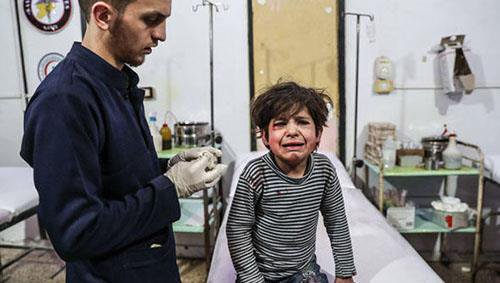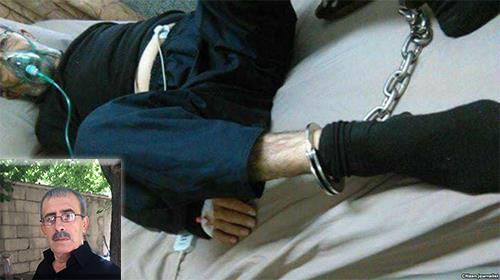Obama red line and Assad’s licence to gas and slaughter 4/15/2018 10:25:50 PM
A distraught child is treated after an attack on Douma, Eastern Ghouta. File Photo
We are living in a time where mass murder has become the norm to retain political power, where arrogant dictators like Bashar al-Assad have been given carte blanche to use sickening force to push through policies of fear and oppression, destroying the homes of hundreds of thousands of helpless unarmed civilians along the way.
While Assad slaughters a vast number of civilians, whose communities voice any dissent against him, the rest of the world has looked on, spouting their disgust with worthless threats against the perpetrators, allowing Assad’s brutal program of ethnic cleansing to continue.
As far as Bashar al-Assad was concerned, the massive street demonstrations calling for him to go in early 2011, was simply a challenge that he was determined to win. It mattered not that the majority of the Syrian population wanted to see an end to his cruel and violent dictatorship, because just like his father before him, he was willing to use all of the violent excesses known to man to remain in power
As the months went by, it became obvious that the uprising was gaining momentum, and so using the brutal tactics that had been taught to him by his father Hafez al-Assad, Bashar implemented a full crackdown across the country, and closing the borders to Amnesty International, various other independent observers, and international journalists, he brought down the full might of his security forces against his people.
As the rage on the streets became more intense, with hundreds of thousands demonstrating across Syria, house-to-house raids were conducted to hunt down leading dissidents, and with thousands thrown into prison, torture became the norm, while vast numbers were hung, and eventually buried in unmarked graves.
In August 2012, after the US intelligence assessed that Syria had a stockpile of chemical weapons, including blister agents, mustard gas, and nerve agents, VX and Sarin, all of which could be delivered via aerial bombs, ballistic missiles, or artillery rockets, President Barack Obama threatened Bashar al Assad with his now infamous “Red Line”, stating that should the Syrian dictator ever use chemical weapons, it would make an American military intervention inevitable, and US bombers would move in.
Half-baked Russian proposal
But when chemical weapons were proved to have been used by Assad against civilians in August 2013, Obama backed down on threats of military action, due to a half-baked Russian proposal, to oversee the destruction of Syria’s chemical weapons, as long as Obama held back from a bombing campaign.
With the Russians having side-lined Obama into making this ill-fated deal, in which the Syrian dictator had supposedly destroyed all of his chemical weapons arsenal, Obama’s inane Red Line statement led to the undoing of US policy in the Middle East.
With the Syrians having continued to use chemical weapons, the result of this deal eventually strengthened Assad’s position, and with America left looking weak through the politics of inaction, Russia and Iran muscled their way into the conflict, and Putin was soon able to call the shots, leaving Obama’s red line a laughing stock.
After the Red Line fiasco, any form of deal became something for Assad to break, ceasefires were only made by the Syrian dictator from a position of strength, when he used them in order to gain an extra military advantage over a besieged opponent.
Then as the Syrian conflict lengthened, Assad’s tactics became more brutal, and to soften up beleaguered opponents, the Syrian air force destroyed essential infrastructure within a besieged community with no thought for civilians, with targets including schools and hospitals, destroyed in bombing campaigns by Assad and his Russian allies.
As the conflict deepened, it became a classic example of today’s wars of attrition, a country where the body count is said to have reached in access of half a million, and where a violent dictator, who is determined to use any violent means at his disposal to cling onto power, uses gas and bombs against the majority of his own people who want to be rid of him.
Ignoring all international laws that are designed to protect innocent civilians, Assad has conducted a vicious military campaign to wipe out all critics of his regime, effectively ethnically cleansing all Sunni communities that might be a future threat to him.

A Syrian Army solider gestures as a Russian flag is seen on a military vehicle, at the entrance of the Wafideen camp in Damascus on April 12, 2018.
The Iranian regime
Through backing Assad on the ground, the Iranian regime has finally acquired Syria as the final block in its Shiite Crescent, and through a voracious bombing campaign carried out by both the Syrian and Russian air forces, hundreds of thousands of Sunnis were forcibly removed from their homes, creating a “living space” for both Iran and its allies.
Through doing so, they are in place to ethnically restructure the Syrian landscape, and once the war is over, Shiite migrants from across the region loyal to the Assad regime, will be resettled in the area to assure the Syrian dictator remains in power.
In the lead up to this, with homes, schools and hospitals flattened by the onslaught of the Syrian air force’s aerial attacks, often with the use of its infamous barrel bombs, maximum fear is generated throughout the various beleaguered enclaves. With a countless number of civilians killed or seriously injured, including a vast number of women and children, there is nowhere to care for the injured.
But it took long enough for the world to wake up to the slaughter taking place in Syria, with one gas attack after another since 2013, having passed without any solid action being taken, even though many of the attacks had been proven to have been the result of Assad’s bombs.
But then came the chemical attack on Douma, which turned out to be the final straw as far as the civilized world was concerned, and a coalition made up by the US, UK and France decided that enough was enough, and they attacked three of Assad’s chemical facilities.
The tipping point finally came on 7 April 2018. As conventional bombs fell in profusion on Douma, reportedly killing dozens, the world’s eyes at first had barely took in the slaughter. But shortly after, pictures came flooding out, showing women and young children, their faces blue with cyanosis, eyes bloodshot and streaming, being scrubbed down by their rescuers, all victims of a calculated chemical attack.
Then as cameras drifted across bodies of children, showing their faces twisted in agonized death masks, many with foam bubbling from their mouths, the world reacted in abhorrence at yet another lethal chemical attack by Assad. It was at this point, the US, France and the UK decided to act, and send a message to Assad and his allies that such attacks are abhorrent, by attacking three of Assad’s chemical weapons sites.
Where the dispersion of the gas was concerned, all evidence points to Assad being responsible for the Douma attack. The modus operandi matched other past attacks, coming at a time when his troops were using any force necessary to crush the opposition, as his bombers were in the skies above Douma, dropping bombs in profusion.
A token strike?
US President Donald Trump may have carried out a token strike against a Syrian air base, but it may be too small to have been effective, especially considering that the Russians were forewarned of the attack. It did little to curb Assad’s ability to deliver chemical weapons.
Just like last year’s attack, the red line laid down for the latest round of strikes wasn’t brushed aside by feckless politicians, who crumble at the first hurdle they come across, and allow such atrocities to continue unabated.
To do so, would have allowed the dictatorial beasts carrying out these atrocities, to have become emboldened enough to go on to create new wars against neighboring countries, turning vast swathes of the Middle East into armed camps.
As far as Assad is concerned, his power has come from his control of the skies, and with none of the opposition forces ranged against him having any form of air power, not only has the Syrian dictator been able to drop lethal gas munitions on innocent civilians, but he has also been able to obliterate neighbourhood after neighbourhood, using cluster bombs, vacuum bombs, incendiary weapons, and barrel bombs.
The latest airstrikes by the US, UK and France, may have set back Assad’s chemical weapons program, but it has left his air force and military fully intact. What was really needed was a much broader series of strikes, to neuter Assad’s control of the skies, plus his ground operations, by destroying as many Syrian air fields as possible, as well as Syrian military bases, which would have severely crippled the regime’s military capability.
Carrying out such strikes, would also have further reduced Assad’s capacity for future attacks against his people, which have been causing thousands more casualties than chemical attacks, through the use of barrel bombs and other insidious ordnance.
Carrying out such broader attacks, would also have sent a far more severe message to both Assad, his allies and other dictators, that the world will not tolerate outlawed weapons of any form being used against innocent civilians.

Tony Duheaume




Comments
Post a Comment